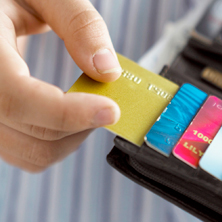
Americans increasingly conduct business electronically. This is not a brand-new phenomenon, of course. Electronic payments—payments that are processed electronically—began to grow rapidly several years ago. Today, consumers and businesses initiate the bulk of the more than 120 billion noncash payments, in the United States each year using debit cards, credit cards, or ACH transactions, according to Federal Reserve studies.
Debit cards
When you use your debit card, the money is quickly, sometimes instantaneously, taken out of your checking account. It is then transferred into the account of the party you are paying.
Debit cards are the fastest-growing method of payment for U.S. consumers, according to Federal Reserve research. The number of debit card payments increased 8 percent annually from 2009 through 2012, the most recent period surveyed by the Fed. Total U.S. debit card payments reached 47 billion in 2012, much higher than the number of credit card payments. Debit card transactions accounted for about 38 percent of all noncash payments. The average dollar amount of a debit card transaction as of 2012 was $39, indicating that consumers use debit cards mostly for routine retail purchases. That figure is less than half the average dollar value of credit card purchases.
Paying with a debit card
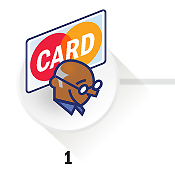
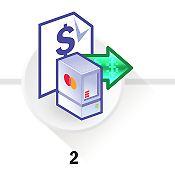
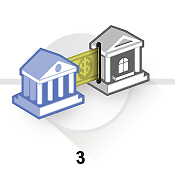
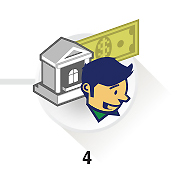
Credit cards
After barely budging from 2006 to 2009, the number of credit card payments rose nearly as quickly as debit card usage from 2009 to 2012. In 2012, credit card transactions totaled 26.2 billion, compared to 21 billion in 2009, according to the 2013 Federal Reserve Payments Study.
For consumers, the main difference between the two cards is that with a debit card, money comes directly out of your bank account, sometimes immediately. With a credit card, you borrow money from the credit card issuer, which pays the merchant for you. Then you receive a bill from the card issuer each month and, if you don't pay the entire balance, you must pay interest to the issuer.
Ever wonder how your pay gets directly deposited to your bank account?
A day or two before payday, your employer's bank sends "files" of payroll information—such as the amount of pay, your bank's routing number, and your account number—to the ACH operator, which then electronically sends the file to your bank.
FedACH Services sends banks such files four times each weekday. Your bank receives the electronic file and posts your pay to your account, usually on the same day. Payment industry rules require that if a bank gets an ACH file before 5 p.m., those funds must be available to the account holder by the opening of business the following day.
Automated clearinghouse
The Federal Reserve System operates one of two major U.S. automated clearinghouses that depository financial institutions use to transmit and receive ACH entries. The ACH network functions like an electronic courier, delivering millions of digital financial packages a day. An ACH transaction takes money directly out of one bank account and delivers it to another, in transactions such as:
- Payroll deposits and Social Security payments
- Automatic monthly bill payments for mortgages, car loans, and power and phone service
- Telephone and Internet payments from checking accounts, such as retail purchases or utility bill payments.
In addition to domestic ACH services, the Federal Reserve provides services that consumers, corporations, and the U.S. Treasury use to send payments from the United States to other countries. FedGlobal ACH Payments offers a safe and efficient means for sending cross-border ACH credit payments from the United States to 35 countries in Europe and the Americas, including Canada, Mexico, Austria, Germany, the Netherlands, Switzerland, the United Kingdom, and Panama. The number of domestic ACH payments made each year is growing and in 2011 surpassed the number of checks written in the United States.
Direct payroll deposit into your account
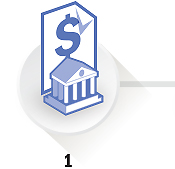
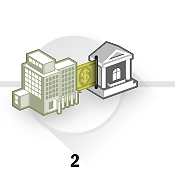
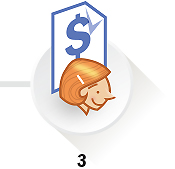
payroll data to your bank.
Online payments
Consumers are increasingly making electronic payments over the Internet—via smartphones, computers, and tablets. Consumers generally make online payments either at the website of a retailer or biller—such as a utility or mortgage company—or at the website of a financial institution. The majority of online payments are processed through the ACH network. Typically, a biller's bank creates an ACH transaction in which the consumer's bank account is debited and the biller's account credited. Online retailers often use proprietary processing networks outside of the ACH network to complete transactions.
There were about 2.5 billion bill-payment transactions initiated by consumers through online banking websites or mobile bill-payment applications in 2012, according to the 2013 Federal Reserve Payments Study. Consumers made 95 percent of those payments through their banks' websites, and the other 5 percent through mobile applications, or "apps," designed to run on smartphones or tablets.
The rise of electronic check conversion
The check collection process has become increasingly electronic. In fact, today virtually all interbank checks—those drawn on a different depository institution than the one at which they were deposited—involve the replacement of the original paper check with electronic payment information, according to Federal Reserve data. In 2007 fewer than half of checks were converted to an electronic packet. Increasingly, fewer checks enter the banking system as paper at all: in 2012 about one in six checks was deposited by account holders as an electronic image rather than paper.
Still, some electronic payments start as paper checks but are then converted to ACH transactions. The check conversion process is usually initiated by merchants at point-of-purchase registers and by large billers, such as telecommunications and power companies. In virtually every case, payment information from the check is converted to a digital document and the original paper check is destroyed.
If a merchant or biller plans to convert your check to an electronic payment processed by the ACH or the debit card networks, the merchant or biller must notify you. You may receive notice in different ways. For example, a utility or credit card company might put a notice in your bill stating that if you pay by check, your check may be used to make an electronic fund transfer from your account. If you pay with a check at a store or other place of business, you will receive notice in two different ways. First, a merchant must post a sign—typically at the register—notifying you that if you pay by check, you are agreeing to let the merchant make an electronic fund transfer from your account. Second, you will be given a copy of the posted notice (or a similar notice) that you can keep for your records. This notice usually appears on your sales receipt.



